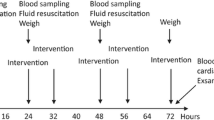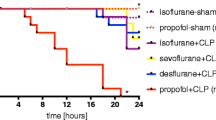Abstract
Background
Carbon dioxide (CO2) pneumoperitoneum has been shown to attenuate the inflammatory response after laparoscopy. This study tested the hypothesis that abdominal insufflation with CO2 improves survival in an animal model of sepsis and investigated the associated mechanism.
Methods
The effect of CO2, helium, and air pneumoperitoneum on mortality was studied by inducing sepsis in 143 rats via intravenous injection of lipopolysaccharide (LPS). To test the protective effect of CO2 in the setting of a laparotomy, an additional 65 animals were subjected to CO2 pneumoperitoneum, helium pneumoperitoneum, or the control condition after laparotomy and intraperitoneal LPS injection. The mechanism of CO2 protection was investigated in another 84 animals. Statistical significance was determined via Kaplan– Meier analysis for survival and analysis of variance (ANOVA) for serum cytokines.
Results
Among rats with LPS-induced sepsis, CO2 pneumoperitoneum increased survival to 78%, as compared with using helium pneumoperitoneum (52%; p < 0.05), air pneumoperitoneum (55%; p = 0.09), anesthesia control (50%; p < 0.05), and LPS-only control (42%; p < 0.01). Carbon dioxide insufflation also significantly increased survival over the control condition (85% vs 25%; p < 0.05) among laparotomized septic animals, whereas helium insufflation did not (65% survival). Carbon dioxide insufflation increased plasma interleukin-10 (IL-10) levels by 35% compared with helium pneumoperitoneum (p < 0.05), and by 34% compared with anesthesia control (p < 0.05) 90 min after LPS stimulation. Carbon dioxide pneumoperitoneum resulted in a threefold reduction in tumor necrosis factor-α (TNF-α) compared with helium pneumoperitoneum (p < 0.05), and a sixfold reduction with anesthesia control (p < 0.001).
Conclusion
Abdominal insufflation with CO2, but not helium or air, significantly reduces mortality among animals with LPS-induced sepsis. Furthermore, CO2 pneumoperitoneum rescues animals from abdominal sepsis after a laparotomy. Because IL-10 is known to downregulate TNF-α, the increase in IL-10 and the decrease in TNF-α found among the CO2-insufflated animals in our study provide evidence for a mechanism whereby CO2 pneumoperitoneum reduces mortality via IL-10-mediated downregulation of TNF-α.



Similar content being viewed by others
References
Are C, Talamini MA, Murata K, De Maio A (2002) Carbon dioxide pneumoperitoneum alters acute-phase response induced by lipopolysaccharide. Surg Endosc 16: 1464–1467
Aurora AR, Hanly EJ, Fuentes JM, Marohn MR, De Maio A, Talamini MA (2004) Isoflurane pretreatment increases survival in a rat model of sepsis. J Surg Res 121: 315
Bachman SL, Hanly EJ, Nwanko JI, Lamb J, Herring AE, Marohn MR, De Maio A, Talamini MA (2004) The effect of timing of pneumoperitoneum on the inflammatory response. Surg Endosc 18: 1640–1644
Barkun JS, Wexler MJ, Hinchey EJ, Thibeault D, Meakins JL (1995) Laparoscopic versus open inguinal herniorrhaphy: preliminary results of a randomized controlled trial. Surgery 118: 703–710
Borovikova LV, Ivanova S, Zhang M, Yang H, Botchkina GI, Watkins LR, Wang H, Abumrad N, Eaton JW, Tracey KJ (2000) Vagus nerve stimulation attenuates the systemic inflammatory response to endotoxin. Nature 405: 458–462
Buanes T, Mjaland O (1996) Complications in laparoscopic and open cholecystectomy: a prospective comparative trial. Surg Laparosc Endosc Percutan Tech 6: 266–272
Casey LC, Balk RA, Bone RC (1993) Plasma cytokine and endotoxin levels correlate with survival in patients with the sepsis syndrome. Ann Intern Med 119: 771–778
Chang CK, Zdon MJ (2002) Inhibition of tumor necrosis factor-alpha and inducible nitric oxide synthase correlates with the induction of IL-10 in septic rats undergoing laparotomy and laparoscopy. Surg Laparosc Endosc Percutan Tech 12: 247–251
Fuentes JM, Talamini MA, Aurora A, Edwards T, Torres MB, Hanly E, De Maio A (2004) Impairment of LPS-induced cytokine release in anesthetized mice. Shock 21: A17
Fuentes JM, Talamini MA, Hanly EJ, Aurora AR, De Maio A (2004) Dose-dependent anesthesia-mediated attenuation of the inflammatory response. J Surg Res 121: 315
Gagné DJ, Malay MJ, Hogle NJ, Fowler DL (2002) Bedside diagnostic minilaparoscopy in the intensive care patient. Surgery 131: 491–496
Glaser F, Sannwald GA, Buhr HJ, Kuntz C, Mayer H, Klee F, Herfarth C (1995) General stress response to conventional and laparoscopic cholecystectomy. Ann Surg 221: 372–380
Gogos CA, Drosou E, Bassaris HP, Skoutelis A (2000) Pro- versus antiinflammatory cytokine profile in patients with severe sepsis: a marker for prognosis and future therapeutic options. J Infect Dis 181: 176–180
Hanly EJ, Bachman SL, Marohn MR, Boden JH, Herring AE, De Maio A, Talamini MA (2005) CO2-pneumoperitoneum-mediated attenuation of the inflammatory response is independent of systemic acidosis. Surgery 137: 559–566
Hanly EJ, Fuentes JM, Aurora AR, Shih S, Marohn MR, De Maio A, Talamini MA (2005) Abdominal insufflation with CO2 causes peritoneal acidosis independent of systemic pH. J Gastrointest Surg 9: 1245–1252
Hanly EJ, Mendoza-Sagaon M, Murata K, Hardacre JM, De Maio A, Talamini MA (2003) CO2 pneumoperitoneum modifies the inflammatory response to sepsis. Ann Surg 237: 343–350
Howard M, Muchamuel T, Andrade S, Menon S (1993) Interleukin-10 protects mice from lethal endotoxemia. J Exp Med 177: 1205–1208
Jakeways MS, Mitchell V, Hashim IA, Chadwick SJ, Shenkin A, Green CJ, Carli F (1994) Metabolic and inflammatory responses after open or laparoscopic cholecystectomy. Br J Surg 81: 127–131
Jatzko GR, Lisborg PH, Pertl AM, Stettner HM (1995) Multivariate comparison of complications after laparoscopic cholecystectomy and open cholecystectomy. Ann Surg 221: 381–386
Kelly JJ, Puyana JC, Callery MP, Yood SM, Sandor A, Litwin DE (2000) The feasibility and accuracy of diagnostic laparoscopy in the septic ICU patient. Surg Endosc 14: 617–621
Moore KW, de Waal Malefyt R, Coffman RL, O’Garra A (2001) Interleukin-10 and the interleukin-10 receptor. Annu Rev Immunol 19: 683–765
Mouret P (1996) How I developed laparoscopic cholecystectomy. Ann Acad Med Singapore 25: 744–747
Orlando R III, Crowell KL (1997) Laparoscopy in the critically ill. Surg Endosc 11: 1072–1074
Rongione AJ, Kusske AM, Ashley SW, Reber HA, McFadden DW (1997) Interleukin-10 prevents early cytokine release in severe intraabdominal infection and sepsis. J Surg Res 70: 107–112
Rongione AJ, Kusske AM, Kwan K, Ashley SW, Reber HA, McFadden DW (2000) Interleukin-10 protects against lethality of intraabdominal infection and sepsis. J Gastrointest Surg 4: 70–76
Tracey KJ, Cerami A (1993) Tumor necrosis factor, other cytokines, and disease. Annu Rev Cell Biol 9: 317–343
Vittimberga FJ Jr, Foley DP, Meyers WC, Callery MP (1998) Laparoscopic surgery and the systemic immune response. Ann Surg 227: 326–334
Watkins LR, Goehler LE, Relton JK, Tartaglia N, Silbert L, Martin D, Maier SF (1995) Blockade of interleukin-1-induced hyperthermia by subdiaphragmatic vagotomy: evidence for vagal mediation of immune–brain communication. Neurosci Lett 183: 27–31
West MA, Hackam DJ, Baker J, Rodriguez JL, Bellingham J, Rotstein OD (1997) Mechanism of decreased in vitro murine macrophage cytokine release after exposure to carbon dioxide: relevance to laparoscopic surgery. Ann Surg 226: 179–190
Yoshidome H, Kato A, Edwards MJ, Lentsch AB (1999) Interleukin-10 suppresses hepatic ischemia/reperfusion injury in mice: implications of a central role for nuclear factor κB. Hepatology 30: 203–208
Acknowledgments
The authors thank Tiffany Edwards for her assistance with animal care in the study experiments. The opinions and assertions contained herein are the private views of the authors and are not to be construed as official or reflecting the views of the Department of Defense.
Author information
Authors and Affiliations
Corresponding author
Additional information
Supported by R01-GM062899-02, National Institutes of Health, Bethesda, MD. Presented at the annual meeting of the Society of American Gastrointestinal and Endoscopic Surgeons (SAGES), Ft. Lauderdale, Florida, 13–16 April 2005
Rights and permissions
About this article
Cite this article
Hanly, E.J., Fuentes, J.M., Aurora, A.R. et al. Carbon dioxide pneumoperitoneum prevents mortality from sepsis. Surg Endosc 20, 1482–1487 (2006). https://doi.org/10.1007/s00464-005-0246-y
Received:
Accepted:
Published:
Issue Date:
DOI: https://doi.org/10.1007/s00464-005-0246-y




